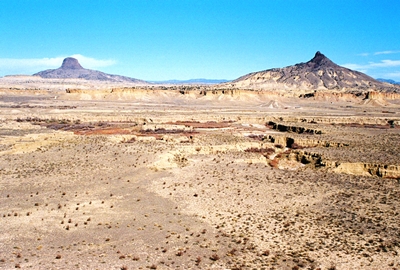
Over the past few years the Río Puerco Valley has become one of my favorite places in New Mexico. About an hour northwest of Albuquerque, with majestic Cabezon Peak always in sight and miles of the Continental Divide Trail close at hand, here you'll find the villages of San Luis, Cabezón, Guadalupe, and Casa Salazar, some of which are essentially ghost towns. No, there aren’t many people around the Puerco Valley anymore and not a lot of its history has been recorded.
However, one person who has done more than any other to ensure that the Río Puerco Valley is not forgotten is historian and folklorist Nasario García. Raised on the banks of the Puerco, Nasario is the subject of a brand new documentary, “Nasario Remembers the Río Puerco,” and following are four of his stories that do not appear in the film, each recollection inspired by photographs from the area.
I’m very proud to feature these stories here and I want to thank Director and Producer Shebana Coelho for making this happen, as well as Nasario García himself, of course. The broadcast premier of “Nasario Remembers the Río Puerco” will be this Thursday, October 12, 2017, at 7PM on New Mexico PBS/KNME Channel 5. I’ve seen the movie and it’s truly wonderful. I highly recommend it to all. For more information, visit Nasario Remembers.
Now, without further ado, City of Dust presents Nasario García and New Mexico’s Río Puerco Valley:
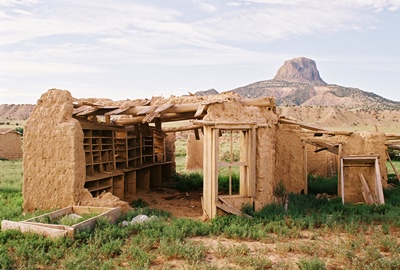
Sal Lovato General Store. Cabezón, New Mexico.
“This store was owned by the Salomón Lovato family. He is one of the contributors to my book, ‘Recuerdos de los Vijeitos.’ You can see where they had different merchandise: canned goods, dried goods and so forth.
“The kind of merchandise they had in these stores was foodstuff that you could not grow, that you could not raise from the land. Here you came and bought, say, lard, even though that wasn't always the case because there was lard from the matanzas. Baking powder, sugar, salt, and some canned goods started coming into existence, as well as dry cereal such as oatmeal. Also, any number of other things—flour, for example. When corn began to become scarce, people would come in the Lovato Store and buy sacks of flour. Those sacks were very important because once the flour was gone the sacks were used to make blouses for the women, blouses for the young girls. In many cases, a young girl would show up at a dance with a rose on the back of her blouse that came from the flour sack. Nobody really looked at you as being odd. That was the moda—fashionable—among many of the families.
“I imagine the store was especially busy on weekends. Of course, a lot of Navajos came from the reservation on weekends. Probably the high point of trading was during the lambing season through the sheering of sheep, which was in May and June. The selling of cattle—those who had cattle—occurred in late September or in October, perhaps even early November. People would make money selling their cattle, selling their sheep. Naturally, that's when they would come to buy a lot of merchandise. But it didn't matter the time of year because many merchants sold on credit. People would pay their bills, say, once or twice a year, whenever they sold their sheep, their wool, their cattle.”
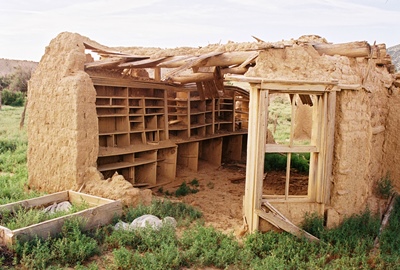
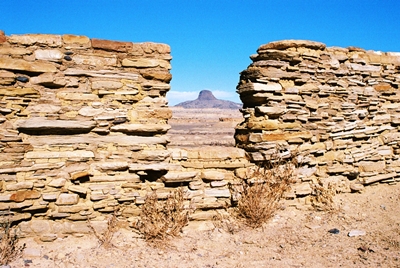
View from Enchanted Mesa Looking Toward Cabezon Peak and Nasario’s Grandpa’s Corral.
“The Enchanted Mesa was right across the Río Puerco from where we lived. That’s the mesa that my paternal grandmother would tell us never to visit because, if we did, we were likely to be turned into goats. My grandmother referred to it as La Mesa Encantada. Many years later, after I left the valley, archaeologists discovered that it was a Chaco Canyon outlier. Now it’s called the Guadalupe Ruins.
“In the evenings, while we were shucking corn, Grandma Lale—her nickname—would tell us stories with the Enchanted Mesa in sight—stories that had to do with the local culture, the local folklore, such as the white donkey, a rarity among donkeys. As she and my Grandpa Lolo, as we called him, told us, they were coming from the placita at night, perhaps after a dance, when suddenly a white donkey appeared and kept pestering the female horse—la yegua—and my grandmother says, as she's telling the story, ‘Look there, I wonder where it came from.’ My grandpa said, ‘I don't know. I know all the donkeys in the valley and I've never seen a white donkey.’ The donkey kept pestering and pestering. ‘Furthermore,’ says my grandpa, ‘there are no white donkeys around.’ My grandmother says, ‘But I am glad this one's here, because a white donkey means good luck. It doesn't mean evil like a black donkey.’
“She would weave these stories, and, in the meantime, we are on pins and needles wondering what's going to happen next. At the end of the story, my grandmother asked my grandfather, ‘Now, truly, what do you think about this white donkey?’ They said they’d turned their heads and the donkey was gone. They never saw it leave. It was stories like this that she liked to share with us grandchildren. She had many, many others.”
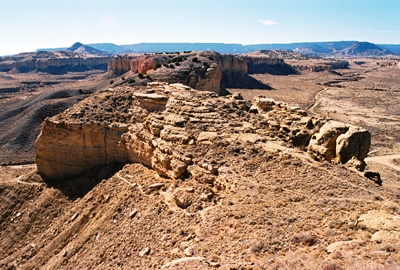
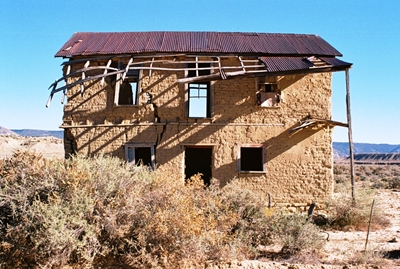
Córdova’s Dancehall. Guadalupe, New Mexico.
“This two-story house was in my village of Guadalupe—Ojo del Padre. The bottom floor was used as a dancehall. This is the only two-story house in the entire Río Puerco Valley that I know of. In fact, today there's probably only a handful left in villages like mine throughout all of New Mexico. This house was built around 1905 by the Juan Córdova family. He was a local merchant. He and his family lived upstairs and downstairs was a store that was periodically turned into a dancehall. There was competition from time to time between this dancehall and the Romero Dancehall. A cousin of mine and I, we were small. I was about seven and my cousin about nine years old. We were supposed to spray water on the dirt floors after every dance because of the dust. Of course, as the men drank more and more and people had more fun, we started bringing in buckets and dousing the floors. By the time the dance was over, these people couldn't move because of all the mud that we had created. My cousin Juan and I had a lot of fun.”
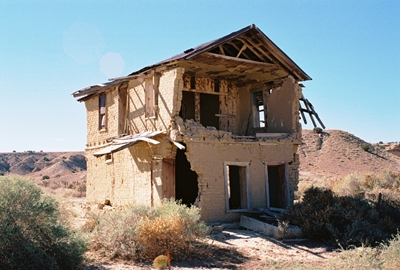
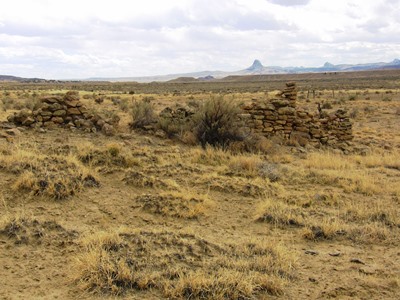
Photo: Shebana Coelho
One-Room Schoolhouse. Guadalupe, New Mexico.
“This was the one-room schoolhouse where I started school. There were about 25 kids from grades one to eight. There were two windows that faced the mesa, but no windows towards the back. That’s where the blackboard was and where the teacher’s desk sat. And towards the middle of the school there was a potbelly stove that the boys had to keep feeding wood into in the winter to keep the room warm. That was our responsibility. The girls had to keep the little barrel of water full. It was wrapped in burlap with a dipper—jumate—hanging from a nail. We all used the same dipper to drink water. We didn’t even wipe it clean the way priests do today when drinking wine from a chalice.
“When I started school here, one teacher taught all the grades and she would line up the boys in one row and the girls in another before entering. There were other times when she would start with the bigger kids. They would walk in first and then the little kids. But most of the time she would line up the younger kids—the first, second and third graders—first, and the older kids were at the back of the room. We had desks that seated two students, usually two boys or two girls.
“The older kids a lot of times would teach the younger how to read, how to do math. So the older kids where helpful. They became teachers. It was very much a communal educational setup. And, believe it or not, we learned. We learned because we learned from one another. Of course, we were supposed to be learning English, but most of us spoke Spanish. When we would read in English we did so with a Spanish accent. We had a book about a dog named Spot. I remember students reading, including myself: “Rrrrrrrrun Espot, rrrrrrrrun.” Because we would pronounce the initial “r” like you would in Spanish and the “s” as in “escribir” —to write. Thus “Rrrrrrun Espot, rrrrrun.”
“And some of the adobes, as you can see, are still here. The school was called, appropriately, “La Mesa School” because of Black Mesa east of the school.”
And so some of the adobes do indeed remain in the Río Puerco Valley, if barely, while many are already gone. Of those shown here, the ruins of the one-room schoolhouse were captured by Shebana Coelho, who was kind enough to allow me to include her shots. Somehow I missed those particular adobe and stone walls myself…for now. Sal Lovato's General Store and Juan Córdova's Dancehall were photographed by me, as were the three views from Enchanted Mesa.
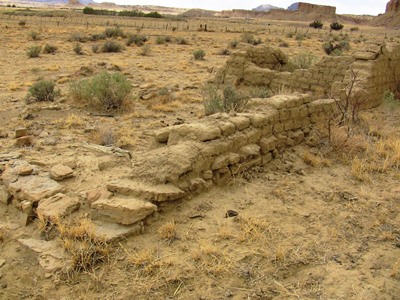 Photo: Shebana Coelho
Photo: Shebana Coelho
Thank you so much for the interesting post, John.
ReplyDeleteTried making it out to Guadaloupe one March afternoon in 2016 but had to turn back after sun set and we still hadn't found the town site.
I look up to both you and Sheila's work a lot and hopefully one day I'll be able to collect and retell history as well as either of you two!
Regards,
Tian
Baltimore, MD
Thank you for your kind words, Yunchen Tian! Guadalupe is a little difficult to find. It took two tries and many hours before I was successful in locating it. Hint: Find the west bank of Rio Puerco and stay close to it!
ReplyDeleteI can see from your website that you're doing excellent work. I wish I could cover as much of the world as you! I was particularly interested to see your posts on the Balkans. I visited Bosnia-Herzegovina and Croatia several years ago and did a post on Sarajevo that's HERE. It's a fascinating and sometimes heartbreaking part of the world that I remain very curious about.
Thanks for getting in touch! JM
You post was thoroughly interesting to me as I too went to a one-room schoolhouse in New Mexico, tho not on a reservation. Your description of the schoolroom was identical to the one I went to. However we all hovered around the stove for warmth in the winter. My mother was the teacher and I was in first and second grade there (all in one year as I would finish the first grade work and then go into the second grade classes. Like you, the older kids would do some of the teaching. My brother Bill was in the fifth grade. And so, I loved your story.
ReplyDeleteI also loved the picture of the two story building, as I had first seen it on Facebook, posted by John Mulhouse. It was some kind of double exposure that showed the top half of the building as a "ghost". I was awed by the picture.
ReplyDeleteHi Judith!
ReplyDeleteThanks for your comments. I'm glad you like the medium format shot of the two-story adobe building so much! I used it at the top of a post I did on the ghost town of Guadalupe, NM itself. You can find that piece HERE.
Would you like me to send you a small print of that photo? I'd be happy to!
John
I enjoyed reading this. My mom grew up in Guadalupe and I remember as a kid going out there to the house she grew up in. My uncle ended up with the house after my grandfather passed away and they were trying to fix it up but I don’t know what ever happened to the house after that. Mr. Garcia spoke to my grandmother and she’s in one of his books. I remember seeing the book he gave her when I was young but I don’t know which book it is. It’s really great to hear these stories.
ReplyDelete